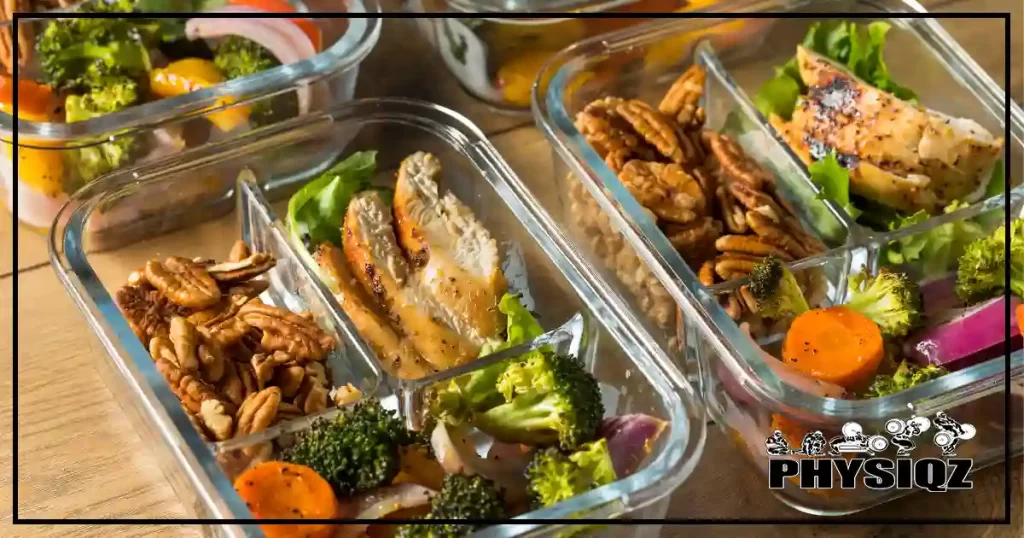
The real answer to the question if you can eat whatever you want if you workout is both yes and no.1 This is because you can consume any foods you want and still lose weight if you’re in a calorie deficit (which means you’re burning more calories than consumed). And for building muscle, any food can be eaten if it fits your macros.
But ultimately, neither of these routes are optimal, leave gains or fat loss on the table, and usually only works for beginners since novice to advanced lifters and dieters alike will have to work harder to see results.
Do You Have to Diet or Eat Well to See Results From Working Out?
Many variables play a part in how food affects the body. While working out seems like the golden ticket to removing accountability from meals and snacks, there needs to be a closer investigation of the caloric details to find out the truth.
While calories in versus calories out is an absolute statement, TDEE (total daily energy expenditure or how many calories you burn) varies widely from person to person; in fact, a single person’s TDEE can vary greatly from day to day.
So scientifically speaking, if calories consumed are less than or equal to the TDEE, weight should be lost or maintained.
However, it is likely that someone will have lesser or no weight loss results if they continue to eat anything they want on a workout regimen.
Eating Freely While Working Out: Can You Still Lose Weight?
When first beginning a workout routine, the body is very inefficient at exercise which, in turn, burns a remarkable amount of calories in a relatively small window of time. So, when food is not controlled and a bunch of calories is burned, it is likely that some weight loss will be seen at first.
However, as workouts continue and weight is lost, the cardiovascular system becomes more efficient; while this is good news for the body, depending on the exercise, calories might be burned at a slower pace.2 For instance, if someone goes for a run every day, the calories burned on day 1 will be significantly higher than the calories burned on day 100, even if the distance and pace remain the same.
Weight lifting is an exception to the above rule because when the muscle is gained at a significant rate, calories will be burned at a faster pace due to increased mass and the ability to lift more weight.
Therefore, if food habits remain the same, the calorie deficit that was once resulting in weight loss can be reduced or completely counteracted as one gains more muscle.
Building Muscle: Is Eating Whatever You Want Compatible with Working Out?
Those who aren’t worried about weight loss but, instead, are looking to build muscle, may wonder if they can eat whatever they want if they are working out. And the truth is, many weightlifters follow IIFYM or if it fits your macros, but this diet is subpar in comparison to clean eating.
While it may be tempting to throw caution to the wind and not pay attention to what and how much is being eaten, it is important to realize the impact that nutrition plays in muscle growth.
Research has found that the quality and quantity of calories as well as the timing of when they are eaten play a large role in strength training performance as well as post workout muscle recovery.3

Source: bhofack2 via Canva.com4
In other words, while it is possible to gain muscle while eating anything, consuming food with little restraint while strength training will result in a substantial amount of wasted effort evidenced by exhausting lift sessions, longer recovery time, and smaller muscle gains.
Downsides of Working Out & Eating Unhealthy
Just because results from exercise without dieting are possible, especially in the early stages of a routine, doesn’t mean it is a good option. The consequences of overeating and choosing empty calories can result in the following:
- Slow Results, Plateaus, or Weight Gain: When not paying attention to calories consumed, there is no way to know how much of a calorie deficit is being achieved. This can drastically reduce or counteract cardio and strength training results. Spending time, energy, and effort working out can be completely negated due to eating excess calories.
- Lack of Energy: Constantly overindulging in low-quality food can lead to poor sleep habits, feeling overly full, and actually becoming malnourished. Being malnourished does just reference lack of food, but the inadequacy of calories that are being consumed. All of these things can lead to feeling drowsy, lethargic, and sluggish.
- Diminished Health: Deciding not to employ any restrictions when it comes to food can be dangerous. Although working out may neutralize some issues, there are many concerns that cannot be prevented if eating is uncontrolled. Long-term ramifications of poor eating habits can include diabetes, high blood pressure, heart disease, etc. Exercise may delay these issues, but if eating poorly is a continued habit, then these problems and diseases may be inevitable.
- Mental Issues: Studies show a strong link between an uncontrolled diet and mental health problems such as anxiety, depression, loss of self control, inability to focus, etc.5 These can come as a result of the above-mentioned health issues or they can exist independently. Once poor eating choices begin to affect mental health, it can be difficult to break the cycle. Becoming addicted to food is a real issue that many people try to combat and have a hard time overcoming.
How to Eat Whatever You Want – Stay Skinny or Get Fit
As touched on above, to achieve the freedom to eat while working out, maintaining a calorie deficit and adhering to a balanced diet are essential. However, for the best health and fitness results, there are a few other tips and tricks to eat anything and still lose weight or get fit.
Intuitive Eating
Rather than meticulously monitoring calorie counts, consider intuitive eating by listening to your body’s cues to understand its needs. Be determined to eat only when hungry and stop when full; this approach may allow for a wider range of food choices with fewer consequences due to mindfulness.
Intermittent Fasting
Numerous intermittent fasting plans for beginners, as long as they are adhered to within the designated time frame, do not impose limitations on the type or quantity of calories consumed. Because there is only a small window for meals, fewer calories are typically consumed per day.
Incorporate a Cheat Day
Instead of eating anything and everything every day, consider sticking to a balanced diet throughout the week that includes plenty of fiber and protein, and then, indulging in a cheat day. So, rather than feeling deprived, know that a cheat day is coming and it can help you get in good nutrition a majority of the time. However, it’s important to determine the appropriate caloric intake on a cheat day before indulging excessively.
Eat in Moderation
Before indulging in a favorite food, consider dialing back the amount that is being eaten. Typically, the first few bites of food are the most satisfying; so, save the calories and reduce the portion size, and still indulge in the food that is irresistible.
Count Calories
You can technically eat “whatever you want” and still count calories; you just may not be able to eat as much as you want using this method. Giving a limit to daily caloric intake can provide a safety net to ensure that excessive calorie consumption doesn’t occur. Allowing flexibility in the types of calories consumed permits enjoying a variety of foods, provided they fit within the daily calorie limit. However, this doesn’t mean you can’t explore methods for maintaining weight without counting calories.
How Much Should You Exercise in Order to Eat Whatever?
As mentioned earlier, when considering whether you can eat whatever you want while exercising or while in a calorie deficit during workouts, the primary determinant is the balance between calorie intake and calories burned through physical activity.
One way to know if a current exercise routine is sufficient is by tracking weight changes. To do this successfully, it will be helpful to track calorie intake or eat fairly consistently for 2 weeks while doing typical workouts. At the end of this 2 week period, if weight is lost, there is a calorie deficit, but, if weight is gained, then there is a calorie surplus.
If the above trial ends in a surplus, the amount of calories being burned by exercise is not sufficient and will need to be adjusted. It may be beneficial to use this body weight planner, provided by the U.S.6 Department of Health and Human Services, to determine how much to increase physical activity to achieve a deficit.
Because many factors can affect TDEE, it may be necessary to conduct the above trial on a regular basis to ensure a calorie deficit is still being achieved.
Although it is technically possible to eat whatever you want while working out, it’s not the optimal choice. Therefore, finding alternative methods to incorporate enjoyable food without hindering weight loss and fitness progress will lead to the highest level of success.
References
1MStudioImages. “Two sporty women eating pizza.” Canva. Accessed 8 April 2023. <https://www.canva.com/photos/MAEIy51bqW0-two-sporty-woman-eating-pizza-/>
2Byrne, C., & Mackenzie, S. (2022, January 5). 6 Factors That Can Affect How Many Calories You Burn. Everyday Health. Retrieved August 2, 2022, from <https://www.everydayhealth.com/fitness/factors-that-can-affect-how-many-calories-you-burn/>
3Volek, J. S. (2004, April). Influence of nutrition on responses to resistance training. PubMed. Retrieved August 2, 2022, from <https://pubmed.ncbi.nlm.nih.gov/15064597/>
4bhofack2. “Homemade Keto Chicken Meal Prep.” Canva. Accessed 7 April 2023. <https://www.canva.com/photos/MADerA5ty-A-homemade-keto-chicken-meal-prep/>
5Mental health problems in relation to eating behavior patterns, nutrient intakes and health related quality of life among Iranian female adolescents. (2018, April 27). NCBI. Retrieved August 1, 2022, from <https://www.ncbi.nlm.nih.gov/pmc/articles/PMC5922554/>
6U.S Department of Health and Human Services. (n.d.). Body Weight Planner | NIDDK. National Institute of Diabetes and Digestive and Kidney Diseases. Retrieved August 2, 2022, from <https://www.niddk.nih.gov/bwp>